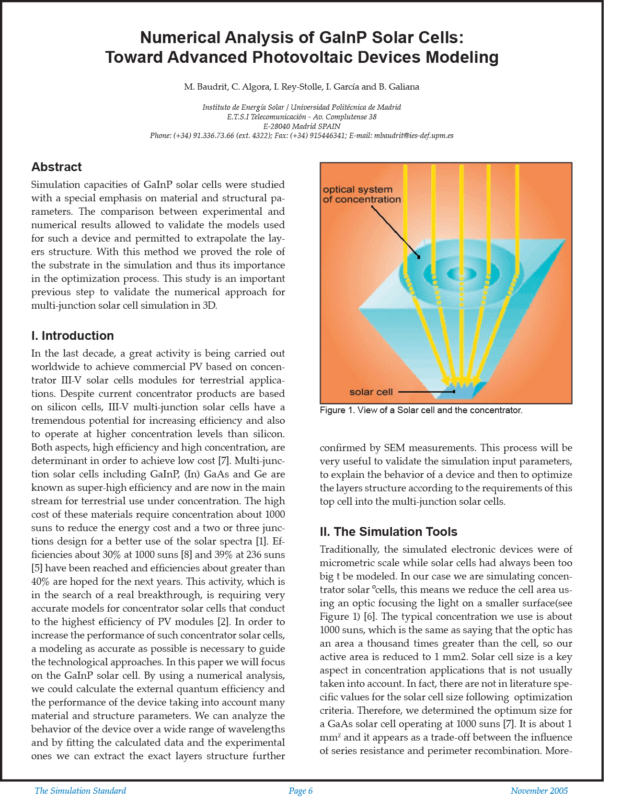Numerical Analysis of GaInP Solar Cells: Toward Advanced Photovoltaic Devices Modeling
M. Baudrit, C. Algora, I. Rey-Stolle, I. García and B. Galiana
Instituto de Energía Solar / Universidad Politécnica de Madrid
E.T.S.I Telecomunicación&Av. Complutense 38
E-28040 Madrid SPAIN
Phone: (+34) 91.336.73.66 (ext. 4322); Fax: (+34) 915446341; E-mail: mbaudrit@ies-def.upm.es
Abstract
Simulation capacities of GaInP solar cells were studied with a special emphasis on material and structural parameters. The comparison between experimental and numerical results allowed to validate the models used for such a device and permitted to extrapolate the layers structure. With this method we proved the role of the substrate in the simulation and thus its importance in the optimization process. This study is an important previous step to validate the numerical approach for multi-junction solar cell simulation in 3D.
Introduction
In the last decade, a great activity is being carried out worldwide to achieve commercial PV based on concentrator III-V solar cells modules for terrestrial applications. Despite current concentrator products are based on silicon cells, III-V multi-junction solar cells have a tremendous potential for increasing efficiency and also to operate at higher concentration levels than silicon. Both aspects, high efficiency and high concentration, are determinant in order to achieve low cost [7]. Multi-junction solar cells including GaInP, (In) GaAs and Ge are known as super-high efficiency and are now in the main stream for terrestrial use under concentration. The high cost of these materials require concentration about 1000 suns to reduce the energy cost and a two or three junctions design for a better use of the solar spectra [1]. Efficiencies about 30% at 1000 suns [8] and 39% at 236 suns [5] have been reached and efficiencies about greater than 40% are hoped for the next years. This activity, which is in the search of a real breakthrough, is requiring very accurate models for concentrator solar cells that conduct to the highest efficiency of PV modules [2]. In order to increase the performance of such concentrator solar cells, a modeling as accurate as possible is necessary to guide the technological approaches. In this paper we will focus on the GaInP solar cell. By using a numerical analysis, we could calculate the external quantum efficiency and the performance of the device taking into account many material and structure parameters. We can analyze the behavior of the device over a wide range of wavelengths and by fitting the calculated data and the experimental ones we can extract the exact layers structure further confirmed by SEM measurements. This process will be very useful to validate the simulation input parameters, to explain the behavior of a device and then to optimize the layers structure according to the requirements of this top cell into the multi-junction solar cells.



